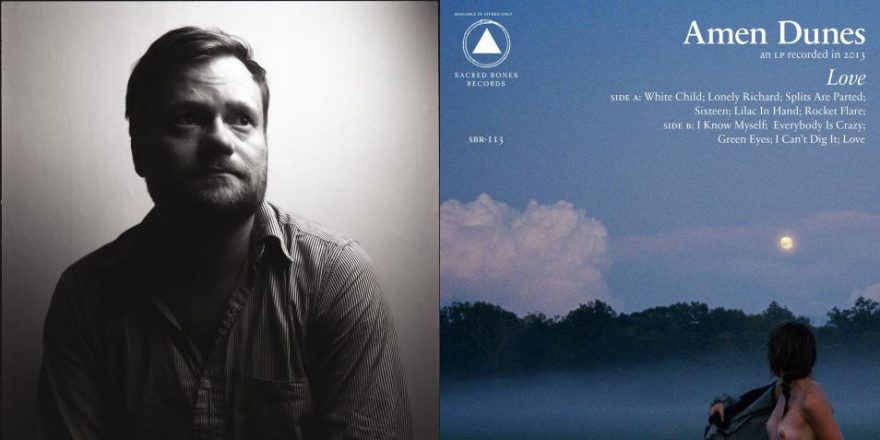I first heard of Panda Bear when I was a student living in Los Angeles. I came home from class and a bizarre concoction of noise was emanating from my friend’s bedroom. I leaned in. His bathroom, which was adjacent to his bedroom, was monkey-themed. His shower curtain and towels had the imprint of red monkeys, spiraled hand-in-hand like double helixes. This image was a perfect companion to the music that was playing. Later, I found out that it was the album Person Pitch (2007) by Panda Bear, the solo project of Noah Lennox, one-fourth of Animal Collective.
It had nostalgic references to the old masters. Lee Perry, Brian Wilson and the Dust Brothers (to name a few) were the most fluid referents, but Noah definitely took a critical leap forward. In my brief and inexperienced opinion, music sometimes has to be derivative, joining the listener to auras of a previous time while also warping and squeezing out something new. Person Pitch was a fine example of this. There was the very clear homage to the Beach Boys’ Pet Sounds (1966) as well as acid house, spooled through infinite feedback loops and a dense vortex of field recordings and synthesizers. The recording quality was also rough and unpolished, like the musical result of several tape recorders playing back, erasing and transferring sonic information across cables in a garage somewhere. And on top of that, the angelic nature of Noah’s voice served as a guide through the chaos. It was like a hand on your shoulder, letting you know that the trip was going to be OK.
Panda Bear’s later albums, while retaining the Rorschach Test-like density of Person Pitch, moved ahead with a more polished production. Person Pitch bore the sonic imprint of different impromptu recording spaces. It was like a silent partner in the minute dead-space of the music, in the form of room tones and hiss. Rusty Santos, a very gifted engineer and producer who mixed my band Dawn of Midi’s record Dysnomia (2013), also mixed Person Pitch, as well as Animal Collective’s breakout album Sung Tongs (2004). Panda Bear’s recent EP Mr Noah (2014) and, more importantly, his full-length Tomboy (2011) had an increasingly airtight sound, perhaps due to the influence of Peter “Sonic Boom” Kember, a former member of Spaceman 3 who took the production helm from Tomboy onwards and returned for Noah’s latest, Panda Bear Meets the Grim Reaper.
Noah’s latest further explores the idea of the finely polished, while revisiting some of the cosmic slop and unidentifiable noise that flows beneath his earlier records. This is a departure from the minimalism of Tomboy and a re-imaging of his earlier process, where disparate influences collide and reform in new ways.
For me, Panda Bear’s originality lies in the chasm of difference between his voice, which has a sky-blue clarity and innocence, and the musical mood, which captures the feeling of taking LSD and lovingly welcoming anything that wishes to crawl all over your body and tell you stories. All the while, clouds are shooting laser beams into an eight-bit purple sea. One of the things I love most about Panda Bear’s music is his ability to evoke a strong visual experience in the listener.
The musical contour of …Meets the Grim Reaper is inviting. It teeters on the edge of bubblegum, but it’s also covered in a generous patina of strangeness. The opening track, “Sequential Circuits,” sets up the experience as a sermon-like ritual. Organ passages radiate and Noah’s melody spirals and catches up with itself in a slow rotation. In my warped mind, it feels like a weird call to prayer for a cul-de-sac development in the San Fernando Valley. In fact, the album seems to vacillate between plastic goodness and violent sonic rips. It’s almost lighthearted in its exchange between these two worlds. The second track, “Mr Noah,” begins with the apparent sound of dogs as they’re jettisoned through a wormhole. What follows is one of the filthier guitar and drum grooves within Panda Bear’s arsenal. Again, the melodic contour is very recognizable, like a shampoo commercial from the ’60s, but the surrounding music denotes the arrival of deep space pulsars that are up to no good.
For a good part of the album, there is this same generous back-and-forth. The visual trip that his music sets you on is really palpable, at times making it impossible to focus on anything other than what you’re hearing. “Come to Your Senses” is a good example of that feeling. “Tropic of Cancer” and “Lonely Wanderer” are on a slightly different trajectory. There’s a really nice harp sample taken from Pyotr Ilyich Tchaikovsky’s The Nutcracker on “Tropic of Cancer” that moves throughout like a gentle sway back and forth through the thistles. If I were a white teenage boy living in Indiana in the ’50s (both of which I’m not), this track would be the perfect backdrop for a summer love. These two pieces almost serve as a halftime special, with the intent of cleansing the ear and wiping the space of all the sonic critters. “Lonely Wanderer” has a slightly off-kilter piano phrase, repeating ad infinitum with an occasional low, murky crack. It’s off in the distance like an approaching storm. The digital warble that takes up so much of the foreground earlier in the record now takes a bit of a backseat. It’s more like fireflies dancing around you at night, with the occasional sound of errant insects getting burnt to a crisp on a fly light. For the remainder of the album, we exit the wooded labyrinth with “Principe Real” and enter Fashion Week on Jupiter, lovingly so.
Panda Bear’s trajectory and alchemical process has been so consistent over the years, and his music has changed with small and austere steps. You think of people like Madonna, or anyone in the über-star gauntlet, and what causes bated-breath salivation among their fans is the anticipation of the next move, and how different it’ll be from the last; the face swap, the new “African Sound” that they’ve latched onto, the Yacht-Rock resurgence or the overnight transformation from a good to a nasty girl (or boy). But with Panda Bear, you hear his entire catalogue and within a few seconds you know that it’s Panda Bear. The digital flora and fauna that brush at the feet of your listening experience will always remind you of Noah Lennox.








